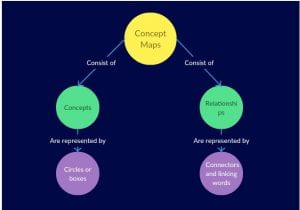Concept mapping
Concept mapping is a brainstorming technique used to visualise ideas. Other brainstorming techniques include mindmapping, fishbone diagrams, SWOT analysis and starbursting. A concept map is a top-down diagram or graphic tool showing the relationship between concepts, including cross connections among concepts and their examples. Concept maps begin with the main concept and breaks down into specific ideas using circles or squares and connecting them with labelled arrows or lines.
How can concept maps help you?
Concept maps are useful because they reduce large amounts of information and present them visually. Creating concept maps enhance learning as you are actively engaged with the information. Concept maps are described as meaningful learning and they deepen understanding as you try and establish links between concepts.
You may access a useful resource which explains the importance of linking in a concept map:
http://tutorials.istudy.psu.edu/conceptmaps/conceptmaps7.html#userbookmark_Principles
Key characteristics of a concept map
Nodes
Nodes are the circles or boxes that are used to represent an idea. Nodes may vary in size, the more general nodes at the top may be bigger than the more specific nodes which follow.
Cross-Links/connections
You may also show relationships between the circles or boxes with labelled arrows or lines.
Linking words
Linking words or phrases show the relationship between two concepts and are written on the line connecting them
Hierarchical structure
This means the more general terms/concepts are at the top and then the map moves down to the more specific terms like examples. Concept maps are read from top to bottom.
Free-form concept map – could start from the centre and branch out
Propositional structure
Each concept has links to more specific details and these links form a sentence.
For example in the figure below you can see:
1. “Concept maps” and “concepts” are linked with a phrase – together it reads: Concept maps consist of concepts
2. “Concepts” and “Circles or boxes” have linking phrases in between and together they read: Concepts are represented by circles or boxes
How to draw a concept map
You may draw a concept map by hand or by using a software tool.
Some steps to think about before your draw your concept map
1. Brainstorm your topic – think about facts, concepts, ideas, terms related to the topic
2. Build up concept to elaborate key concepts – you may start from the top and move down or start in the centre and move out. Make sure the main idea/topic stands out – use a bigger box or circle.
3. Identify links between concepts – establish links to gain a deeper understanding of a topic
– Identify connections/links and write down the linking words or phrases. This will show the relationship between ideas/concepts.
– Next look for cross links – do concepts link from different areas?
Watch this YouTube video on How to make a concept map:
https://www.youtube.com/watch?v=8XGQGhli0I0
You can create your own concept map by downloading a tool called Creately:
You may practice by creating a concept map on the following topics:
1. How to bake a chocolate cake
2. My career journey
Checklist for creating concept maps
Criteria-for-concept mapping to see whether you have created an effective concept map.
Resources adapted from:
Creately – The Ultimate list of essential visual brainstorming techniques . www.creately.com
Penn State university – https://libraries.psu.edu/research/how/creating-concept-map-tutorial

